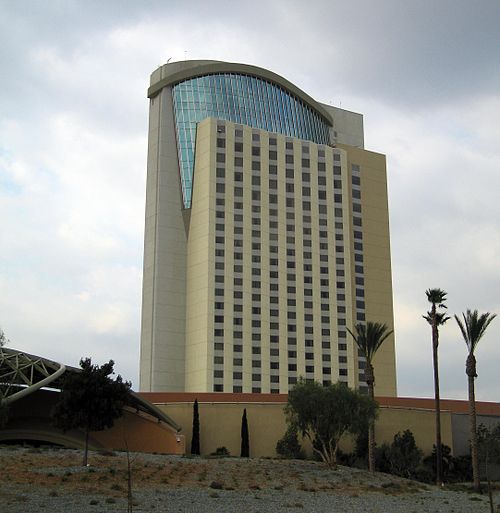 Moravian Church on the Morongo Reservation | |
| Total population | |
|---|---|
| 996[1] | |
| Regions with significant populations | |
| United States (California) | |
| Languages | |
| English, PassCahuilla, andSerrano.[2] | |
| Religion | |
| traditional tribal religion, Christianity (Roman Catholicism)[3] | |
| Related ethnic groups | |
| otherCahuilla,Cupeño, andSerrano peoples |
TheMorongo Band of Mission Indians is afederally recognized tribe in California, United States. The main tribal groups areCahuilla andSerrano. Tribal members also includeCupeño,Luiseño, andChemehuevi Indians.[4] Although many tribes in California are known asMission Indians, some, such as those at Morongo, were never a part of theSpanish Missions in California.
TheMorongo Reservation is located inRiverside County, California in theSan Gorgonio Pass. Established as thePortrero Reservation by executive order in 1876 under PresidentUlysses S. Grant, and calledMalki by the Native Americans, theMorongo name was adopted by 1908 when the land waspatented to the Morongo Band of Mission Indians.[5] The tribe has developed a large casino and hotel resort atCabazon to generate revenues for tribal welfare and economic development.[1]

TheMorongo Reservation (33°57′10″N116°48′28″W / 33.95278°N 116.80778°W /33.95278; -116.80778) is located at the base of theSan Gorgonio andSan Jacinto Mountains. It is more than 35,000 acres (14,000 ha) in size. On May 15, 1876, PresidentUlysses S. Grant established this and eight other reservations in the area byexecutive order.[6] Approximately 954 of the 996 enrolled tribal members live on the reservation.[1]
The nameMorongo is derived from the Serranoclan,Maarrenga. The first official "Captain" ofPotrero Ajenio (akaSan Gorgonio Agency), recognized by theBureau of Indian Affairs, was the hereditary leader of the Maarrenga, known to Americans by his English name, John Morongo. As time went on, the Bureau began to refer to the tribe as theMorongo Band of Mission Indians.
The Morongo Band of Mission Indians is headquartered inBanning, California. They are governed by a democratically elected tribal council. Their current administration is as follows:
The reservation runs its own education services, including independent college prep high schools and pre-K through 8th grade schools. The reservation is planning to add a high school, and natives not living directly on the reservation are zoned to theBanning Unified School District.[7]
Cahuilla andSerrano areTakic languages, part of theUto-Aztecan language family. The main aboriginal group of the San Gorgonio Pass are Pass Cahuilla, who call the areaMaalki. The Serrano, who had traditionally intermarried with the Pass Cahuilla, and who have lived in the area since well before the inception of the reservation, call the areaMaarrkinga'.
The Cahuilla and Serrano languages are technically considered to be extinct as they are no longer spoken at home, and children are no longer learning them as primary languages.[8] Joe Saubel, a Morongo tribal member and the last pure speaker of Pass Cahuilla, died in 2008. The last pure speaker of Serrano was an enrolled member at Morongo, Ms. Dorothy Ramon, who died in 2002. Recent generations have found a renewed interest in their native languages, however. Many families are working to have their children educated to speak Pass Cahuilla and/or Serrano.[9]
In 2012, the Limu Project announced that it had successfully reconstructed Pass Cahuilla, and it is offering an online course.[10] The project also offers online courses in Maarrenga' (Morongo Band "Serrano" dialect) and Yuhaviat (Santos Manuel Band "Serrano" dialect).[11]

The tribe opened a small bingo hall in 1983, which became the foundation of what is now one of the oldest Native gaming enterprises in California. The government ofRiverside County, California, attempted to shut down the bingo hall. The tribe joined with theCabazon Band of Mission Indians in suing the local government, a case that eventually was decided by theU.S. Supreme Court. On February 25, 1987, the court upheld the right of sovereign Indian tribes to operate gaming enterprises on their reservations.[12]
TheMorongo Casino, Resort & Spa was opened in 2004 inCabazon, California.[6] It is open seven days a week, 24 hours a day. The hotel has 310 rooms. Several restaurants and bars are part of the complex: Desert Orchid: contemporary Asian cuisine, Potrero Canyon Buffet, Cielo: Pacific Coast Steak and Seafood Restaurant, Serrano, Sunset Bar and Grill, a food court, Mystique Lounge, and the Pit Bar. The club, 360, is open on weekends.[13]
The tribe participated in development of a water bottling plant on the reservation. It is operated byNestle Waters North America Inc., which leases the property from the tribe. The plant bottlesArrowhead spring water, as well as purified water sold under the brandNestle Pure Life. In his 2010 book,Bottled and Sold: The Story Behind Our Obsession with Bottled Water, author Peter H. Gleick said the plant was producing more than 1 billion bottles of Arrowhead spring water per year.[14]
TheMalki Museum on the Morongo Reservation is open to the public. It maintains the Malki Museum Press, which publishes theJournal of California and Great Basin Anthropology and scholarly books on Native American culture. The reservation is also home to the Limu Project, a tribal community-based nonprofit organization that helps families preserve knowledge of their indigenous languages, history, and cultural traditions.[15]
Two churches are on the Morongo Reservation. They are the ProtestantMorongo Moravian Church and the Catholic St. Mary's Mission, maintained by theSaint Kateri Tekakwitha Catholic Community.[16][17]
33°57′10″N116°48′28″W / 33.95278°N 116.80778°W /33.95278; -116.80778